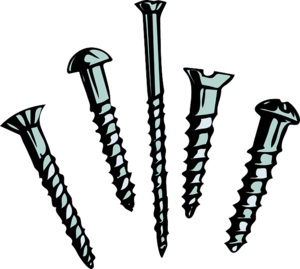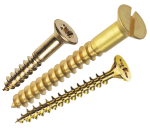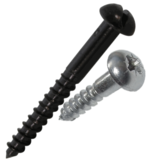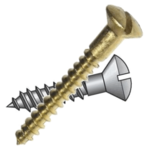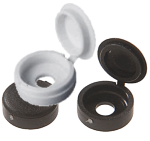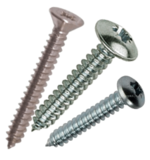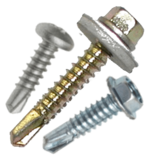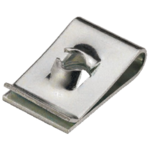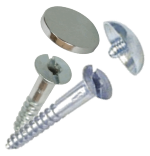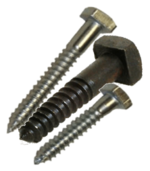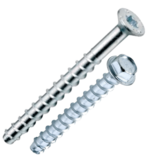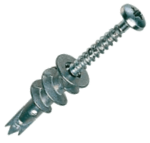Woodscrews and Self-Tappers: Difference between revisions
From DT Online
mNo edit summary |
m (Added text and images) |
||
| Line 15: | Line 15: | ||
{| | {| | ||
|- | |- | ||
| [ | | [https://en.wikipedia.org/wiki/Screw#Screw_head_shapes '''Countersunk Head Woodscrews'''] | ||
| The most commonly used woodscrew used where the head has to finish flush with the surface. The traditional '''Slot Head''' screw is now largely superceded by [https://en.wikipedia.org/wiki/List_of_screw_drives#Phillips '''Philips'''] and [https://en.wikipedia.org/wiki/List_of_screw_drives#Pozidriv '''Pozidrive'''] head types. They are most commonly available made in [https://en.wikipedia.org/wiki/Steel '''Steel'''], often [https://en.wikipedia.org/wiki/Electroplating '''Electroplated'''] to reduce [https://en.wikipedia.org/wiki/Corrosion '''Corrosion'''] or to improve appearance, but woodscrews made of [https://en.wikipedia.org/wiki/Brass '''Brass'''] for example are also common. | | The most commonly used woodscrew used where the head has to finish flush with the surface. The traditional [https://en.wikipedia.org/wiki/List_of_screw_drives#Slot '''Slot Head'''] screw is now largely superceded by [https://en.wikipedia.org/wiki/List_of_screw_drives#Phillips '''Philips'''] and [https://en.wikipedia.org/wiki/List_of_screw_drives#Pozidriv '''Pozidrive'''] head types. They are most commonly available made in [https://en.wikipedia.org/wiki/Steel '''Steel'''], often [https://en.wikipedia.org/wiki/Electroplating '''Electroplated'''] to reduce [https://en.wikipedia.org/wiki/Corrosion '''Corrosion'''] or to improve appearance, but woodscrews made of [https://en.wikipedia.org/wiki/Brass '''Brass'''] for example are also common. | ||
---- | ---- | ||
<span style="color: green">'''Note:''' | <span style="color: green">'''Note:''' | ||
Brass woodscrews are sometimes used with [https://en.wikipedia.org/wiki/Oak '''Oak'''] because of concerns about the effect of Oak's [https://en.wikipedia.org/wiki/Tannic_acid '''Tannic Acid'''] on steel ones, but it is advised first to screw in ''(and then out)'' a steel screw to avoid the screw breaking, since Oak is such a dense [https://en.wikipedia.org/wiki/Hardwood '''Hardwood'''] | Brass woodscrews are sometimes used with [https://en.wikipedia.org/wiki/Oak '''Oak'''] because of concerns about the effect of Oak's [https://en.wikipedia.org/wiki/Tannic_acid '''Tannic Acid'''] on steel ones, but it is advised first to screw in ''(and then out)'' a steel screw to avoid the brass screw breaking, since Oak is such a dense [https://en.wikipedia.org/wiki/Hardwood '''Hardwood'''] | ||
</span> | </span> | ||
---- | ---- | ||
| [[File:CskHdWoodscrews.png|150px|right]] | | [[File:CskHdWoodscrews.png|150px|right]] | ||
|- | |- | ||
| [ | | [https://en.wikipedia.org/wiki/Screw#Screw_head_shapes '''Round Head Woodscrews'''] | ||
| These can be used where the material is too thin to countersink or where the screw head is intended to add decoration. They are commonly used to fix metal fittings on to wood - an application for which [https://en.wikipedia.org/wiki/Japanning '''Black Japanned'''] slot head types were used traditionally. | | These can be used where the material is too thin to countersink or where the screw head is intended to add decoration. They are commonly used to fix metal fittings on to wood - an application for which [https://en.wikipedia.org/wiki/Japanning '''Black Japanned'''] slot head types were used traditionally. | ||
---- | ---- | ||
| Line 33: | Line 33: | ||
| [[File:RndHdWoodscrews.png|150px|right]] | | [[File:RndHdWoodscrews.png|150px|right]] | ||
|- | |- | ||
| [ | | [https://en.wikipedia.org/wiki/Screw#Screw_head_shapes '''Raised Countersunk Woodscrews'''] | ||
| These can be used for fixing thicker components on to wood and where strength is required as well as decoration. | | These can be used for fixing thicker components on to wood and where strength is required as well as decoration. | ||
| [[File:RsdHdCskWoodscrews.png|150px|right]] | | [[File:RsdHdCskWoodscrews.png|150px|right]] | ||
|- | |||
| '''Screw Cups''' | |||
| These can be used when using ''''Counter Sunk Head''' or '''Raised Head''' woodscrews with thinner materials or to present a neater finish generally. | |||
| [[File:ScrewCups.png |150px|right]] | |||
|- | |||
| '''Plastics Screw Covers''' | |||
| Most commonly used to hide the head of a '''Counter Sunk''' woodscrew when assembling products made from laminated [https://en.wikipedia.org/wiki/Particle_board '''Chip Board'''] ''(e.g. home assembly kitchen cabinets]''. | |||
| [[File:PlasticScrewCover.png|150px|right]] | |||
|} | |||
====Screws for Metals and Plastics==== | |||
{| | |||
|- | |||
| [https://en.wikipedia.org/wiki/Self-tapping_screw '''Self-Tapping Screw'''] | |||
| Used to screw together thin sheet metal, these are made of hardened steel such that they can cut their own threads into a previously drilled hole. | |||
| [[File:SelfTappingScrews.png|150px|right]] | |||
|- | |||
| [https://en.wikipedia.org/wiki/Self-tapping_screw '''Tec Screw'''] | |||
| Similar to '''Self-Tapping''' screws but with the addition of a tip shaped to enable it to drill its own hole to screw into. | |||
| [[File:TecScrews.png|150px|right]] | |||
|- | |||
| [https://en.wikipedia.org/wiki/Clip-on_nut '''Spire Nut''' ''(aka U Nut)''] | |||
| These can be clipped on to thin sheet materials to provide a stronger thread to receive '''Self-Tapping''' screws. | |||
| [[File:SpireNut(aka U Nut).png|150px|right]] | |||
|} | |||
====Special Purpose Screws==== | |||
{| | |||
|- | |||
| [https://en.wikipedia.org/wiki/Self-tapping_screw '''Mirror Screw'''] | |||
| # | |||
| [[File:MirrorScrews.png|150px|right]] | |||
|- | |||
| [https://en.wikipedia.org/wiki/Self-tapping_screw '''Coach Screw'''] | |||
| # | |||
| [[File:CoachScrews.png|150px|right]] | |||
|- | |||
| [https://en.wikipedia.org/wiki/Clip-on_nut '''Screw Eye''''] | |||
| # | |||
| [[File:ScrewEye.png|150px|right]] | |||
|- | |||
| [https://en.wikipedia.org/wiki/Clip-on_nut '''Concrete Screw Anchor''''] | |||
| # | |||
| [[File:ConcreteScrewAnchors.png|150px|right]] | |||
|- | |||
| [https://en.wikipedia.org/wiki/Clip-on_nut '''Plasterboard Fixing''''] | |||
| # | |||
| [[File:PlasterboardFixing.png|150px|right]] | |||
|} | |} | ||
[[Category:Fixings and Fastenings]] | [[Category:Fixings and Fastenings]] | ||
Revision as of 12:50, 2 September 2015
Although originally limited to Slot Head (i.e. for Woodscrews) and Square Head (i.e. for Coach Screws), Screws and Bolts of almost all types are now available with a wide variety of head designs and methods of driving them.
The screws listed here are those with a point, rather than a fully parallel shank, and are used mainly for wood, plastics, sheet metal or similar and some building materials.
For details of screws more suitable for Engineering applications (e.g. Set Screws, Cap Screws and Grub Screws, see the page on Nuts, Bolts and Washers
Woodscrews
| Countersunk Head Woodscrews | The most commonly used woodscrew used where the head has to finish flush with the surface. The traditional Slot Head screw is now largely superceded by Philips and Pozidrive head types. They are most commonly available made in Steel, often Electroplated to reduce Corrosion or to improve appearance, but woodscrews made of Brass for example are also common.
Note: Brass woodscrews are sometimes used with Oak because of concerns about the effect of Oak's Tannic Acid on steel ones, but it is advised first to screw in (and then out) a steel screw to avoid the brass screw breaking, since Oak is such a dense Hardwood |
|
| Round Head Woodscrews | These can be used where the material is too thin to countersink or where the screw head is intended to add decoration. They are commonly used to fix metal fittings on to wood - an application for which Black Japanned slot head types were used traditionally.
Note: Whenever Slot Head screws are used, it is good practice to line up all the screw slots to improve the appearance of the finished product. |
|
| Raised Countersunk Woodscrews | These can be used for fixing thicker components on to wood and where strength is required as well as decoration. | |
| Screw Cups | These can be used when using 'Counter Sunk Head or Raised Head woodscrews with thinner materials or to present a neater finish generally. | |
| Plastics Screw Covers | Most commonly used to hide the head of a Counter Sunk woodscrew when assembling products made from laminated Chip Board (e.g. home assembly kitchen cabinets]. |
Screws for Metals and Plastics
| Self-Tapping Screw | Used to screw together thin sheet metal, these are made of hardened steel such that they can cut their own threads into a previously drilled hole. | |
| Tec Screw | Similar to Self-Tapping screws but with the addition of a tip shaped to enable it to drill its own hole to screw into. | |
| Spire Nut (aka U Nut) | These can be clipped on to thin sheet materials to provide a stronger thread to receive Self-Tapping screws. |
Special Purpose Screws
| Mirror Screw | # | |
| Coach Screw | # | |
| Screw Eye' | # | |
| Concrete Screw Anchor' | # | |
| Plasterboard Fixing' | # |
